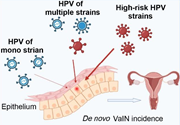Influence of cervical treatment methods on subsequent vaginal lesions: A study of HPV-related neoplasia
DOI:
https://doi.org/10.17305/bb.2024.10523Keywords:
Cervical intraepithelial neoplasia, vaginal intraepithelial neoplasia, human papillomavirus, menopausal status, treatment methods, risk analysisAbstract
The development of cervical and vaginal intraepithelial neoplasias (CIN and VaIN) is strongly associated with human papillomavirus (HPV) infections, representing key precancerous conditions in women. This study investigates the influence of different cervical treatment methods on the rate of subsequent vaginal neoplasia. It also considers age and menopausal status as risk factors for higher-grade VaIN and the role of persistent HPV infections in the development of new VaIN cases post-treatment. The cohort consisted of 275 female patients treated for CIN, with a follow-up period of six months including HPV and ThinPrep cytologic test (TCT) testing. The evaluated treatments included laser therapy, cervical conization, loop electrosurgical excision procedure (LEEP), and radical hysterectomy. Statistical analysis was performed using SPSS 26.0 to determine treatment efficacy, the impact of age and menopausal status, and the relationship between HPV clearance and VaIN outcomes. Radical hysterectomy was linked with a higher recurrence of VaIN. Additionally, patients over 50 years old and those who were postmenopausal were significantly more likely to develop more severe VaIN and persistent HPV infections. Persistence of HPV after treatment was linked to a higher incidence of new VaIN cases. High-risk HPV significantly increased the recurrence of VaIN, with no significant link found between TCT results and VaIN severity. Therefore, selecting appropriate cervical lesion treatment, considering the patient's age and menopausal status, and managing HPV infections are essential in preventing and managing the risk and progression of VaIN. Radical hysterectomy showed a distinct increase in VaIN incidence, emphasizing the need for individualized clinical assessments.
Citations
Downloads

Downloads
Published
Issue
Section
Categories
License
Copyright (c) 2024 Yuanyuan Chen, Haizhen He, Xiaoqian Wang, Yan Ye, Jiajia Pan

This work is licensed under a Creative Commons Attribution 4.0 International License.









